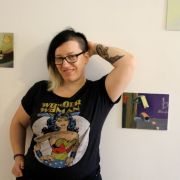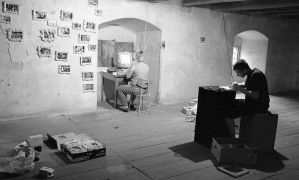Bubblegum – Am. (mullina täispuhutav) vahutav närimiskumm
We used colour pencils to turn ordinary chewing gum into a pink or blue or green bubblegum. Coca-cola- Am. kokakoola
We didn´t have Coca-Cola when I was kid. However, my neighbors had a bottle. It was full and sealed and it was displayed among crystal vases and porcelain behind a glass in a cabinet in their house. We sometimes played there with their daughter and as we looked at the bottle., we wondered how it taste. We would fantasize and think all sorts of ways how to describe the taste unknown to us. --- I remember gigantic oranges atop high shelves – the most mouth – watering thing when I was four. ---
Jeeans, Dzhiinid, dzhiiniriidestt.
Levis Eve wrote in 1982: „Last week I visited Jogeva and I won 11 rubles on Spirit. I was lucky this time! Andrus bought me a new pair of jeans. Can you imagine? They were too small! Oh, I was so angry. Otherwise, they were such cool trousers! I hope maybe I can get, somehow, another pair…“
Chewing gum – flavored gum that is chewed but not swallowed
Chewing gum lasts up to three months of careful composition –
In April 1983 my friend Tiiu wrote: „Once, when I was a girl around ten, we took an excursion to Karjala. I can´t remember much about it except that I wore a striped jumper at the time, and that every evening we ate a terrible pea soup which made me sick for the entire night. Also, that in Karjala there were lots of Finnish tourists, and of course they didn´t like Russians, since it meant Soviet kitchen culture. There, they carry with them from Finland. You, Mare, wrote that rubbish can be beautiful. Yes, indeed it was very beautiful. I confess with horror, that picked up with my neighbor girlfriend all sorts of rubbish from the roadside: chewing-gum wrapping-papers and other types of packages, images with strawberries, raspberries, cheese-papers and whatever else. You understand, it was most beautiful for us! ---
Markers – not in English-Estonian dictionary. In 1981, my friend Eve, who was twelve at the time, wrote me a letter: „How many pupils are in your school, if you know? In our school there are 73 pupils. Too little. Soon they will close down our school. I don´t know where to go then. Maybe I´ll go to Alatskivi. Do you have twelve color markers? I have a set of three color. Sometimes, there twelve color sets in the shop here, but I have not seen them. I collect stamps and envelopes with pictures, books and postcards. What do you collect? ---
I used to treasure my Marlboro plastic bag. I never used it without another bag inside, which would protect it from breaking. And when it got broken, I tried to fix it with an iron, but that made a bigger hole, yet it fixed the first one. That concerned me. The bag lasted around a year, and it was a headache to get a new one.
Mare Trala, 1999 Plasy
Mare Tralla is interdisciplinary artist, organiser and activist. Graduated Estonian Academy of Arts Department of Painting (BA 1995) and received an MA in hypermedia from the University of Westminster, London in 1997. Mare Tralla’s professional art career started in Estonia in the early 90s, where she became one of the leading interdisciplinary artists of the younger generation. Drawing from her personal history and everyday experience her practice was in direct critical response to how the transition period of East-European societies affected women. She was one of the very few conducting a feminist revolution in the field of contemporary art in Estonia. She employs and combines variety of media, from video, photography, performance and painting to interactive media. As an activist she is involved with Act Up, London, No Pride in War coalition and LGSMigrants. Her recent socially engaged performative projects deal with queer experiences, gender issues, HIV stigma, investigate sustainability and economics. Her curatorial practice include: the first Estonian feminist exhibition Est.Fem (1995 co-curated, with Eha Komissarov, Reet Varblane), a touring Estonian-British feminist exhibition “Private Views” (1998-99), accompanied by a book “Private Views: Spaces and Gender in Contemporary Art from Britain and Estonia” (eds. Angela Dimitrakaki, Pam Skelton, Mare Tralla, WAL, 2000), the programme chair for ISEA2004 in Tallinn, wearable technology event for Gateways, exhibition, KUMU 2011, “Act Up- Art Up”, Ritzy, London 2016. As an educator, she has worked at the Estonian Academy of Arts; as visiting lecturer at Central Saint Martins, University of Westminster, she has given many workshops and talks internationally.
Her recent text contributions can be found at “Watched! Surveillance, Art and Photography “,Buchhandlung Walther König, 2016; “re.act.feminism a performing archive”, eds. Bettina Knaup and Beatrice Ellen Stammer, Verlag für Moderne Kunst, Nürnberg, Live Art Development Agency, London 2014; ‘quite queer’ ed. Claudia Reiche, thealit Frauen.Kultur.Labor, Bremen 2014
Recent exhibitions include: ‘Give Up the Ghost. Baltic Triennial 13’, Kim?, Riga (2018), ‘Things’, Tamaraprojects, London (2018); ‘Bastard Voices’ launch of Baltic Triennial 13, evening of performances, South London Gallery, London (2018); ‘Women’, Threshold Artspace, Perth, UK (2017-2018); ‘Amor”, Oi Futuro, Rio De Janeiro, Brazil (2016); “Love At the Edge”, Gallery Arsenal Power-station, Białystok, Poland (2015); “1995”, EKKM (Museum of Contemporary Art Estonia) Tallinn (2015); “Aferlife of Gardens”, Art Museum of Estonia KUMU, Tallinn (2013), “Girls Next Door” Visby Art Museum, Sweden (2013), “Hetro.q.b”, Museu do Chiado, Lisbon (2013), “re.act feminism 2”, Academy of Arts, Berlin (2013), Tallinn Art Hall & Fundació Antoni Tàpies, Barcelona,(2012), “Untold Stories “ Tallinn Art Hall (2011), “Gender Check” Zacheta National Gallery of Art, Warsaw (2010) & MUMOK Vienna (2009), “Angled towards the other” Pamenkalnio Galerja, Vilnius & City Gallery, Tallinn (2011), “Crazy Love” Tartu Art House, Tartu (2011), “Retrospective video exhibition”, Threshold Artspace, Perth, UK (2011)



